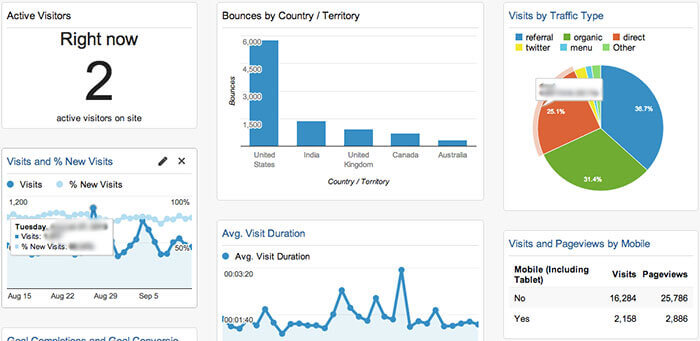What is Google Analytics?
In short, it is an all-in-one statistics platform that lets you keep track of where your site visitors come from, what they are looking for, what content they are consuming, how long they stay on your site, and more.
However, while Google Analytics is fairly easy to use and navigate, it can take some time to master all of its intricacies and make the most of it.
For example, there are various settings on the analytics platform that can be changed to increase the amount of information you receive about your site visitors.
Introduction to Google analytics

Google Analytics is a web analytics tool that provides valuable information about your website traffic.
Whether you run a personal website or a multi-million dollar business, Google Analytics can help you track your website traffic.
It will even help you understand how visitors interact with your site so you can improve it.
Best of all, Google Analytics is free.!
In a few minutes, we'll show you how to set up Google Analytics on any WordPress site that requires no coding.
Sit back, relax and let us guide you through everything you need to know about Google Analytics for WordPress sites.

Google Analytics Basics & Why I Need It
Google Analytics is a free web analytics tool developed by Google to help you measure traffic to your web site.
The tool provides basic data about your website visitors, their sites, their activities and much more as well as reports on how they interact with your content.
It basically shows you what people do when they visit your site so you can make decisions based on those results.
You can also use it to track your social media presence on sites like Facebook and Twitter.
Although the Google Analytics will not provide every detail of your business, it will give you an idea of how users interact with your product or service.
![]()
GA tracking code application
Once you have set the tracking code, you will want to make sure your pages are tracked.
To do this, go back to your GA account and click Conversions in the Behavior area.
This will show you all the goals you have set for Google Analytics.
If they are not already enabled, enable them by clicking Enable Target Tracking for each target to be tracked.
Make sure each target also has the appropriate label.
Otherwise, it will not be registered as a conversion when someone does something (ie clicks on a link). Also make sure you specify which page should activate each target this can usually be found in the confirmation email from Google or by returning to your GA account.
Then go to Goals in Traffic Sources> Overview and check if any of your goals are missing from here. If so, add them now before proceeding.

Customize the Google Analytics dashboard
The first thing you will want to do when setting it up Google Analytics is to change the control panel.
The default view provides you with a lot of information that is not very useful for measuring the performance of your website.
Instead, adjust your dashboard to include only those statistics that are important, such as source views (where do people find your content?) And page time (how long do they stay?).
This will prevent you from being overwhelmed with too much data and will make it easier for you to keep track of your progress over time.
You can also create custom reports, which allow you to collect all kinds of metrics related to your website performance.
For example, if one metric is more important to you than others at any given time, creating a custom report will allow you to see exactly how it is performing.
This way, you can take action if needed but otherwise know where to focus. It will also help you keep things clear about what is most important.
To learn more about Google Analytics metrics and how they apply to your business development, see here.

View audience trends
Perhaps one of the most underused features of Google Analytics is its Audio section.
This may seem strange, as marketing professionals often say that demographics are more important than traffic sources, but they are true.
If you can see who your site visitors are demographically and understand how they interact with your site you can tailor the content to their needs to make the user experience as enjoyable as possible.
Check which websites your users visit before they visit yours, so you know what additional content may be valuable to them on yours and which you may want to avoid for fear of expelling potential customers.
Also, take a look at the devices that people use to access your site (so you can optimize for mobile) and where people are when they visit (so you can customize bids for specific locations).

Basic Google Analytics metrics
To get started with Google Analytics, you may want to familiarize yourself with a few metrics.
Traffic Sources is a very important page because it will tell you how users find your site (or do not find it). The two most important numbers here are direct traffic and organic search.
Instant traffic refers to users who type in your domain or visit your site directly via a bookmark or a saved link. this is 100 percent controlled by you.
Organic search means that Google sends traffic to your site, ranking you high in search results based on keywords that are relevant to what you are writing about.
There are many other sources of paid search traffic, social media referrals, email campaigns but all of these will also be tracked in Referrals.
This section also gives you a good idea of where to focus your time if you are trying to increase an audience for your site.
If 80 percent of people come from Facebook but only 10 percent from Twitter, maybe it's time to put in more effort to get more followers on Twitter!
Good reports for starters, Standard Google Analytics reports
Although they are only available for campaigns AdWords, these reports are free for anyone using Google Analytics.
The standard report provides you with more than enough information about how users interact with your site.
To use it effectively requires a little technical knowledge as well as trial and error on your part, but it is one of those powerful features that will make your job easier once you understand how to get ahead of it.
Once you understand how all these reports work together (and especially when you start using Google Tag Manager), then switching to the Premium Report will not be that big of a deal.
These advanced features will help you to give even more information about what works on your site in order to further optimize your strategy.
Tying the data together, google analytics 101
Many managers get stuck on data that is often much less valuable than it seems at first glance.
For example, visits are a key metric for marketing analysis.
However, just because anyone who has worked in digital marketing for any length of time knows that just because someone visited your site did not mean they were concerned with your content or turned it into a potential customer.
Once you understand what each data point means, it's time to take action by segmenting users into groups based on their behavior.
This will allow you to target different sections with specific messages and prompts for action.
This is one of the many ways to use Google Analytics effectively.
Conclusion for google analytics
So now that you know how much Google Analytics can do for your business, you need to start using it right away.
If you're already using Google Analytics (or any other web analytics platform), make sure you keep track of everything that matters to your company's results.
Next, consider these 5 things when setting up your GA (or preferred web analytics platform) to provide an accurate picture of what is happening to your site right now.
In the next article we will show you how to connect google analytics with WordPress. For any information we are at your disposal.




LATEST NEWS
Πώς να φτιάξεις τα δικά σου Viber stickers σε 4 βήματα;
MoreΟδηγίες βήμα‑βήμα για την αναβάθμιση PHP WordPress (Ελλάδα)
MoreViber για επιχειρήσεις 2025 – Chatbots, πληρωμές, διαφημίσεις AI
More